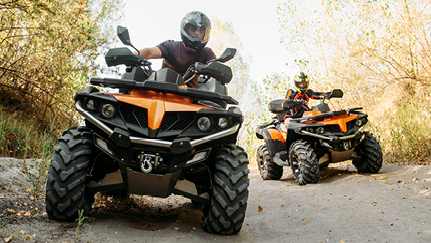ATVs and UTVs are different vehicles. They serve different purposes, and have different insurance needs.
What is an ATV?
At its simplest, an all-terrain vehicle (ATV) is defined as a vehicle with the following: a straddle seating position, handlebar steering, and the ability to maneuver through a variety of terrain conditions. While there are a variety of ATV customizations and modifications available, at their base all ATVs share those three features.
Wheels and Tires
ATVs have either three or four wheels. Tires are kept at a lower pressure than standard car or UTV tires.
Steering
The operator can steer the ATV by using handlebars.
Seating and passenger capacity
On an ATV, the operator is seated in a straddle position. ATVs are normally built for just one rider, some are made to carry the operator and one passenger.
Speed and handling
ATVs are not “one-size-fits-all” and should be sized appropriately for the operator.
When operated safely and correctly, ATVs offer a quick and nimble means of transportation over a variety of terrain.
Braking and acceleration
The majority of stock ATVs come with a thumb throttle. Pressing the throttle with the thumb controls acceleration. It is possible to modify an ATV to use a twist throttle, which allows the operator to control the vehicle’s acceleration by twisting the ATV’s handle.
Given the unpredictable nature of the terrain ATVs cover, twist throttles can make it difficult and dangerous to control the vehicle. For example, if a rider leans forward and unknowingly twists the throttle while going downhill, the vehicle may unexpectedly pick up speed. This can easily cause the rider to be thrown forward off of the vehicle, and the vehicle may roll and fall on the rider.
To brake, operators can use either the brake handle or the foot pedal, depending on what type of ATV they are operating.
Safety equipment
ATVs often do not come with safety equipment as part of the vehicle. Some do have “roll bars”—strong steel pipes that form a cage-like structure around the operator to provide protection if the vehicle rolls.
ATV operators should strongly consider wearing protective clothing, boots, and gloves—and should always wear a helmet.
Cabin
ATVs are open and do not have a cabin. However, as mentioned above, some do have roll bars.
Uses
As a quick means of transportation over rough ground, ATVs are a valuable tool. However, they are mainly used for recreation, like racing or trail riding.
Cost
Compared to UTVs, an ATV is a much more budget friendly option. When planning their purchase, potential buyers should make sure to account for the additional costs of safety gear and insurance.
ATV insurance needs
While ATVs can be used safely, accidents happen. And when they do, being on the back of a powerful vehicle without seatbelts isn’t the safest place to be. That’s why you should always make sure you’re properly protected—first with gear, and then with insurance.
Medical coverage is an important option to consider for ATVs, which lack many of the safety features of UTVs. Nationwide offers this and other ATV insurance options.
